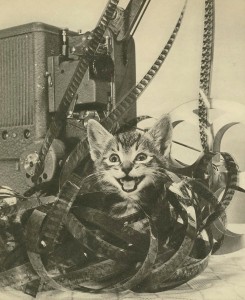***Please note that there are no screenings on September 7th or October 26th***
These films will screen Wednesday nights at the Portage Theater on 4050 N. Milwaukee Ave.
Shows start at 7:30 – Admission is $5
Programmed and Projected by Julian Antos, Becca Hall, and Kyle Westphal.
Home Movie Day is coming – bring us your films!
On Sunday, October 16th we will be hosting “Home Movie Day Northwest” in collaboration with the Chicago Film Archives and the Northwest Chicago Historical Society. Home Movie Day is a worldwide event celebrating the prolific celluloid output of amateur filmmakers – that means you, or maybe your aunt or your neighbor or your dorky cousin – in the 20th century. Members of the public are invited to bring in home movies or other celluloid artifacts on any film format – 8mm, Super 8, 16mm, or beyond. We’ll inspect them and screen them on-site in the Portage Theater lobby. Come any time between 1 PM and 6 PM (it’s okay if you don’t have a film to share). There will be snacks!
———————-
September 14th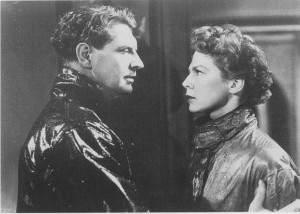
I KNOW WHERE I’M GOING!
Directed by Michael Powell and Emeric Pressburger • 1945
Determined to escape her middle-class background, stubborn 25-year-old Wendy Hiller leaves her home in Manchester with plans to marry a wealthy old industrialist in Scotland, but gets stranded on the Island of Mull and falls in love with a young Naval Officer instead. By the time Hiller can get to her fiancé, she has no reason to. Shot in monochrome by Erwin Hillier, Powell and Pressburger’s most visually impressive film is also their most humbling. Per James Agee, “The sensitive photography and intelligent use of sound do more than enough to make eloquent the influence of place on people.” Showing humans in heaven (A Matter of Life and Death) is one thing, but A Canterbury Tale and I Know Where I’m Going, The Archers’ two films in which the English landscape is as much a character as anything else, make heaven out of earth. (JA)
91 min • The Archers/The Rank Organisation • 35mm from MGM
Puppetoon: “Together in the Weather” (1946, George Pal) – 16mm Kodachrome
September 21st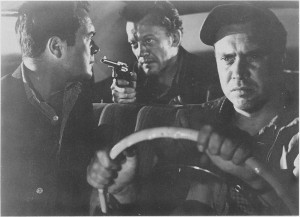
THE HITCH-HIKER
Directed by Ida Lupino • 1953
Based on the true-life story of Billy Cook and adapted in part from a short story by then-blacklisted Out of the Past screenwriter Daniel Mainwaring, The Hitch-Hiker stars Edmond O’Brien and Frank Lovejoy as two longtime-pals-on-a-fishing-trip and William Talman as the mass-murdering psychopath they pick up. Directed the same year as Lupino’s The Bigamist, a weird little weepie about a young couple trying to adopt a baby, The Hitch-Hiker takes place in a totally different world. It’s a tense, leathery thriller with Pre-Code timing, but it’s also remarkably sensitive and honest for an economical piece of film noir. Lupino directs a film that’s more about the relationship between two hostages than an overall feeling of dread and despair, and few films of its kind are so emotionally effective. (JA)
71 min • RKO Radio Pictures • 35mm print Preserved by the Library of Congress
Cartoon: Porky & Daffy in “Thumb Fun” (1952) – 35mm IB Technicolor
September 28th
WESTERN UNION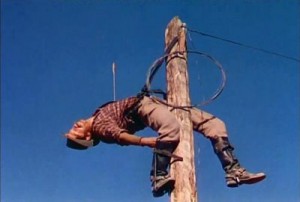
Directed by Fritz Lang • 1941
A very young Randolph Scott is a reformed outlaw laying wire in the Great Plains for the telegraph service. All hell breaks loose when Scott’s brother rounds up a band of degenerates trying to prevent the connecting line between Salt Lake City and Omaha. Made two years after Cecil B. DeMille’s Union Pacific, a similarly great film about America’s similarly great industry, Western Union is a violent (by the end of the film Scott doesn’t have much of his hands left) picture about the breaking in of late nineteenth-century America. The first great Technicolor western, this Kodachrome print (which dates back to 1945) represents some of the best color reproduction possible with ultrasaturated reds, blues, and blacks, and does eye-popping justice (with the exception of some light base scratches) to one of Lang’s most visceral films. With Robert Young and John Carradine. (JA)
95 min • 20th Century Fox • 16mm Kodachrome, permission Criterion Pictures, USA
Short: “Knight of the Trail” (William S. Hart, 1915) – 16mm
October 5th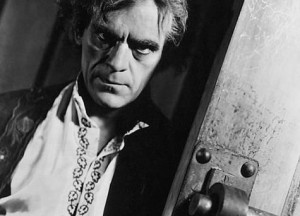
THE BLACK ROOM
Directed by Roy William Neill • 1935
Columbia’s lone effort in the first wave of talkie terror provides an unlikely climax to the whole cycle. Like Universal’s horror pictures, the setting is distinctly generic Mittel Europe, where villagers whisper of prophesies and torture chambers. Two twin brothers—Baron Gregor and Anton de Bergmann (Boris Karloff and Boris Karloff)—have voluntarily separated to stave off a divisive curse: one will kill the other in The Black Room. But Gregor’s brand of landed gentility—homicidal hounds and ravaged maidens across the countryside—calls for a moderate face and so Anton returns to the fold. The lynch mob of Frankenstein finds a political, rather than supernatural, target. A reminder of the top-notch set design, atmospheric photography, and rollicking editing that Columbia’s technicians were more than capable of achieving but rarely called upon to perform, The Black Room is a neglected Gothic classic. (KW)
68 min • Columbia • 35mm from Sony Pictures Repertory
Short: The Three Stooges in “Who Done It?” (1949, Edward Bernds) – 35mm
October 12th
I WANT YOU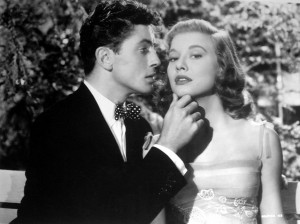
Directed by Mark Robson • 1951
Dana Andrews and his family operate a contracting business in an undisclosed American Small Town at the start of the Korean War. As families begin to worry about their young men going off to fight, pressure mounts on Andrews – considered “essential” by the US government because of his profession – to keep the men he employs out of combat. Though it attempts to be an answer to the Korean War in the same way that The Best Years of Our Lives (also a Samuel Goldwyn production) was to World War II, I Want You ends up being a much more eerie and conflicted picture. Starting at the beginning of combat while Best Years of Our Lives took place in the aftermath of WWII, I Want You has very little to offer in the way of comfort or optimism (though Andrews and Dorothy McGuire are both wonderful and keep everything above water). Instead it’s a fairly bitter look at a handful of middle of the road Americans and the Cold War America they were living with, the sort of picture that seems – for better or worse – to escape becoming dated, if only because it feels so familiar. (JA)
102 min • The Samuel Goldwyn Company • 16mm from the Radio Cinema Film Archive
Cartoon: Daffy Duck in “Draftee Daffy” (Bob Clampett, 1945) 16mm
October 19th
THE GHOST AND MR. CHICKEN
Directed by Alan Rafkin • 1966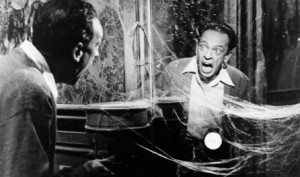
At the end of the fifth season of THE ANDY GRIFFITH SHOW, Barney Fife took a job as a detective in Raleigh and Don Knotts, who played him, left the small town of Mayberry for the motion picture business. The show plugged along for another three (dreadful) seasons after Knotts departed, and though his output for the silver screen was uneven (sadly the most promising of those films, The Reluctant Astronaut and The Shakiest Gun in the West, are pretty dull), The Incredible Mr. Limpet, in which Knotts turns into a talking fish to escape his crazy wife, and The Ghost and Mr. Chicken, which stars Knotts as a newspaper typesetter who spends the night at the house of an infamous murder/suicide per the request of his editor, are two of the most (secretly?) loved pieces of sixties cinema . Look out for a host of ANDY GRIFFITH and BEWITCHED regulars, and (hold on to your hats!) this one’s in S C O P E. (JA) (JA)
90 min • Universal Pictures • 35mm Techniscope from Universal
Talkartoon: “Swing You Sinners!” (1930, Dave Fleischer) – 16mm
***PLEASE NOTE THERE IS NO SCREENING ON THE 26th***
November 2nd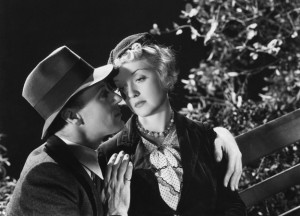
OF HUMAN BONDAGE
Directed by John Cromwell • 1934
Those who think that Oscar-mongering is a recent phenomenon should take a look at Of Human Bondage, wherein Bette Davis invents all the tropes—she climbs down the economic ladder, makes herself ugly with whore’s makeup, and delivers her lines in an aggressively fanciful Cockney accent. Officially adapted from W. Somerset Maugham’s novel, but ultimately more about its own insistent (and conflicting) performance styles than any mere story, Of Human Bondage pits Davis the slut-waitress against Leslie Howard’s sensitive and expressive artist, who repeatedly returns to her through bouts of romantic masochism. Long available only in substandard copies after forgettable remakes forced it from screens, Of Human Bondage emerges now as another directorially understated but uncommonly affecting effort from John Cromwell (The Enchanted Cottage, So Ends Our Night). (KW)
83 min • RKO-Radio Pictures • 35mm preserved by the Library of Congress
Cartoon: “She Was an Acrobat’s Daughter” (1937, Friz Freleng) 16mm
November 9th
THE GIRL CAN’T HELP IT
Directed by Frank Tashlin • 1956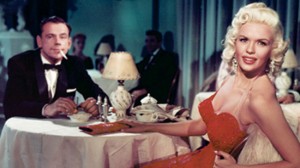
What is rock ‘n’ roll? According to The Girl Can’t Help It, it’s a mob-controlled racket where a no-talent bombshell with a “new sound” can skyrocket up the charts thanks to rigged jukeboxes and a legion of stupefied teenagers. Playing for laughs situations and mantras that would be serious business the next year in Jailhouse Rock, Tashlin’s riotous satire is also a strangely empathetic movie: Jayne Mansfield, the reluctant crooner, obliterates the very sexpot image that Fox was grooming her to fulfill and the music itself plays out in respectful long takes. (Hollywood saw something in rock ‘n’ roll, all right—something that could be shoehorned into cheap exploitation pictures. No other movie has Fats Domino, Little Richard, and the Platters accorded the dignity of color and CinemaScope.) Also featuring Tom Ewell as a beleaguered p.r. problem-solver, Edmond O’Brien as a subliterate gangster with a new sound of his own, and Julie London as the sexiest easy listening ghost you’ve ever heard. (KW)
99 min • 20th Century-Fox • 35mm CinemaScope print from Criterion Pictures USA
Cartoon: “Rooty Toot Toot” (John Hubley, 1951) 16mm
November 16th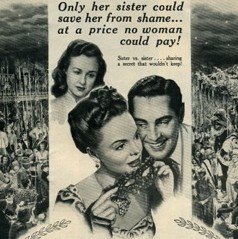
HER SISTER’S SECRET
Directed by Edgar G. Ulmer • 1946
Our Rarest Screening of the Season!
Knocked up at Mardis Gras. Abandoned by her soldier-lover. Forced to pawn her new baby off on her sister. These are only a few of the indignities suffered by Nancy Coleman in Her Sister’s Secret, a superb melodrama that has been improbably neglected in favor of more salacious-sounding Ulmer entries like Girls in Chains and The Amazing Transparent Man. Yet Her Sister’s Secret has something those lack: a budget. After years toiling in the exploitation and Yiddish-language cinemas, Ulmer found steady work at Producers Releasing Corporation turning out cheap time-passers. Modern fans regard Detour as the culmination of this period, but Her Sister’s Secret possesses equal claim, and not just because it was Ulmer’s last for the company; touted as PRC’s “first million-dollar production,” it embodies the scrappy striving that characterized Ulmer’s career. Put over with excellent camerawork from Franz Planer (soon to be snatched up by Max Ophuls and Robert Siodmak), you won’t soon forget Her Sister’s Secret. (KW)
80 min • Producers Releasing Corp • Ultra-rare 16mm from private collection
Screen Song: “Row, Row, Row” (1930, Dave Fleischer) 16mm
November 23rd
IF I HAD A MILLION
Directed by Norman Taurog, Norman McLeod, Stephen Roberts, H. Bruce Humberstone,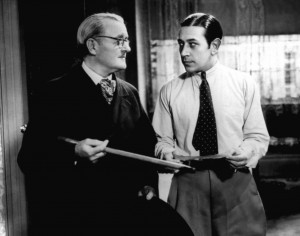
James Cruze, Ernst Lubitsch, and William A. Seiter • 1932
Every now and then, when studios had endless rosters of talent and topflight technicians, they would toss off rambling, oversized ensemble films for the sole purpose of reminding audiences of their plenty. Paramount’s effort was more memorable than most and still beloved to this day. The premise is slender—an elderly tycoon (Richard Bennett) decides to disperse his millions amongst random schmoes in the phone directory—but the diverse notes of tragedy, comedy, and epiphany in the vignettes that follow are rich: Wynne Gibson as a prostitute, relieved that she can finally afford a single-occupancy bed; henpecked china shop associate Charlie Ruggles who spends an exhilarating day at the office; career criminal George Raft who can’t forge his way out of this one; and road-rage-prone W.C. Fields. And that’s only half of it. Content to develop stripped-down but emotionally robust miniatures (the Charles Laughton-Ernst Lubitsch segment might be the two most succinct minutes in the history of cinema), If I Had a Million compares well with today’s ensemble pieces, obsessed as they are with tying together every character through a web of coincidence, fate, and excruciating designs. (KW)
88 min • Paramount • 35mm from Universal
Short: Laurel & Hardy in “Early to Bed” (Emmet J. Flynn, 1928) 16mm
November 30th
MOONLIGHT AND PRETZELS
Directed by Karl Freund • 1933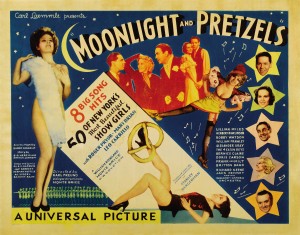
All the studios were trying to duplicate Busby Berkeley’s musical extravaganzas in 1933, but Universal’s effort stands out for its low-budget sincerity and its related shamelessness: the climactic “Dusty Shoes” number is an undisguised rip-off of “Remember My Forgotten Man,” likely conceived and choreographed in an afternoon shortly after Gold Diggers of 1933 opened. The show starts with washed-up singer Roger Pryor flirting with small-town record store operator Mary Brian. His love song to her spurs great Broadway success and the follow-up, Moonlight and Pretzels, promises a characteristic mix of romantic ambition and a disarmingly common touch. (What other musical, even in the ultratopical ‘30s, boasts a song as straightforwardly proletarian as “I’ve Gotta Get Up and Go to Work”?) Directed with considerable panache by once-and-future cameraman Karl Freund in between his twin masterpieces of the ’30s horror cycle (The Mummy and Mad Love), Moonlight and Pretzels emerges as the fullest expression of a particular kind of musical ethos prior to Corn’s-A-Poppin
80 min • Universal • 35mm from Universal
Cartoon: Betty Boop in “Boop-Oop-A-Doop” (1932, Dave Fleischer) – 35mm
Soundies: Spike Jones and His City Slickers, 16mm courtesy Chicago Film Archives
December 7th
LILIOM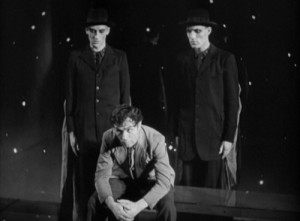
Directed by Fritz Lang • 1934
The last film version of Ferenc Molnár’s 1909 play before Rodgers and Hammerstein’s musical adaptation, Carousel, forever altered the popular profile of the material, Liliom is a surprisingly coarse rendering of irrepressibly fantastic material. Charles Boyer plays the carnival barker Liliom, an argumentative loudmouth who loses his job and soon focuses his meager vocational energies on domestic abuse. His pregnant girlfriend Julie (Madeleine Ozeray) loves him in spite of it all, at least until a botched robbery sends Liliom to a bureaucratic celestial purgatory. The film itself proved almost as transient as the story it depicts: one of the less-than-a-handful of productions to emerge from Fox’s short-lived European operation, Liliom boasts the participation of a number of notable émigrés en route to America—director Fritz Lang, producer Erich Pommer, composer Franz Waxman, and cinematographer Rudolph Maté. In French with English subtitles (KW)
118 min • Les Productions Fox Europa • 35mm print from Criterion Pictures USA
Plus Selected Cartoons
December 14th
HUCKLEBERRY FINN 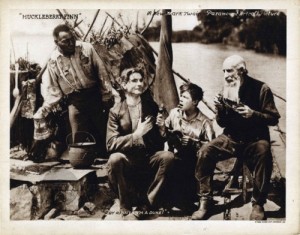
Directed by William Desmond Taylor • 1920
Those expecting a family-oriented silent comedy to embrace the full political and satiric scope of Mark Twain’s Huckleberry Finn have reason to be disappointed. For everyone else, this highly condensed and compressed version of the novel yields many other pleasures: a winning lead performance by Lewis Sargent, beautiful location work (with the Sacramento River standing in competently for the Mississippi), breezy and efficient summertime direction from William Desmond Taylor, Paramount production values, and, above all, an abiding sense of the popular reverence that Twain enjoyed in 1920s America. Restored by the George Eastman House, inclusive of a veritable rainbow sno-cone of tints and a meticulous recreation of the original intertitles. (KW)
75 min • Famous Players-Lasky • 35mm restored by the George Eastman House
With live accompaniment by Jay Warren!
Cartoon: Mississippi Hare (Chuck Jones, 1949) 35mm
December 21st
REMEMBER THE NIGHT
Directed by Mitchell Leisen • 1940
With the sort of wholehearted American 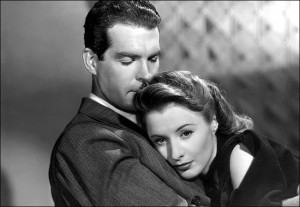 kindness that seems possible only in a Preston Sturges Script (this was his last before he started directing that same year with The Great McGinty), Lee Leander, one of those tough-as-nails shoplifting types best played by Barbara Stanwyck, is bailed out of spending Christmas in prison by her prosecuting attorney (Fred MacMurray). The couple falls in love, but that doesn’t solve the problem of Stanwyck’s upcoming trial and MacMurray’s mother (Beulah Bondi), who worries that the young shoplifter will destroy her son’s hard-earned career. Leisen’s sense of emotional detail gives Sturges’ script a tenderness and depth only really found again in Sturges’ Christmas in July, and Stanwyck and MacMurray, who would star together again in Double Indemnity, The Moonlighter, and There’s Always Tomorrow, only add to that delicate balance. Our third favorite Christmas film, right after Meet Me In St. Louis and The Shop Around the Corner . . . it’s in very good company. (JA)
kindness that seems possible only in a Preston Sturges Script (this was his last before he started directing that same year with The Great McGinty), Lee Leander, one of those tough-as-nails shoplifting types best played by Barbara Stanwyck, is bailed out of spending Christmas in prison by her prosecuting attorney (Fred MacMurray). The couple falls in love, but that doesn’t solve the problem of Stanwyck’s upcoming trial and MacMurray’s mother (Beulah Bondi), who worries that the young shoplifter will destroy her son’s hard-earned career. Leisen’s sense of emotional detail gives Sturges’ script a tenderness and depth only really found again in Sturges’ Christmas in July, and Stanwyck and MacMurray, who would star together again in Double Indemnity, The Moonlighter, and There’s Always Tomorrow, only add to that delicate balance. Our third favorite Christmas film, right after Meet Me In St. Louis and The Shop Around the Corner . . . it’s in very good company. (JA)
94 min • Paramount Pictures • 35mm print from Universal
Short: “The Fairy Princess” (Margaret Conneely) – 16mm courtesy Chicago Film Archives

